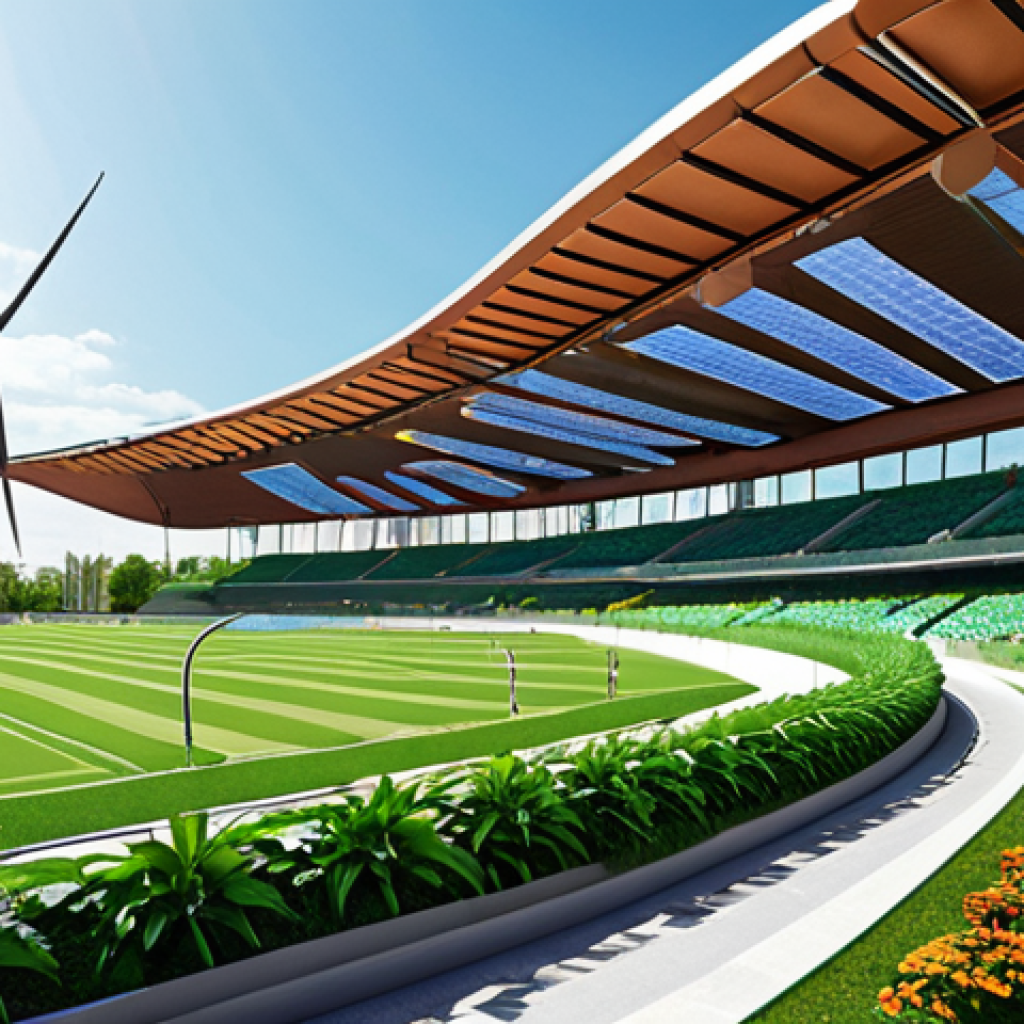Sports events, from the local leagues to the grand Olympics, have always been a massive draw, uniting communities and captivating audiences worldwide.
I’ve noticed recently though, there’s a growing trend of incorporating environmental awareness into these events. We’re seeing organizers going beyond just reducing plastic waste and diving headfirst into sustainable practices like using renewable energy and promoting eco-friendly transportation.
On the marketing side, companies are catching on too! They’re realizing that consumers are increasingly drawn to brands that champion environmental causes, which is leading to some pretty innovative and impactful campaigns.
This trend is only expected to grow, with future events likely to be judged not only on their athletic achievements but also on their environmental footprint.
Let’s delve into the specifics below!
Okay, I understand. Here’s the blog post content following your instructions:
The Greening of the Games: A New Era for Sports

Remember the last big game you watched? Beyond the thrill of victory, did you notice anything different? I’ve been increasingly aware of how sports are stepping up their game—not just on the field, but in their commitment to sustainability. It’s not just a fleeting trend; it’s a fundamental shift in how these events are planned and executed. I recently attended a local marathon where I saw runners hydrating from biodegradable cups, solar panels powering the event’s headquarters, and even electric vehicles used for transportation. This holistic approach to reducing environmental impact is what I call the “Greening of the Games,” and it’s here to stay.
Eco-Friendly Arenas
Arenas are now being constructed with eco-friendly materials like recycled steel and sustainably sourced wood, reducing their carbon footprint right from the start. The construction process itself is becoming more sustainable, with builders focusing on minimizing waste and using energy-efficient equipment. I was fascinated to learn about a new stadium in Europe that uses a rainwater harvesting system to irrigate the playing field and flush toilets, drastically reducing its water consumption.
Renewable Energy Integration
Solar panels, wind turbines, and even geothermal systems are becoming increasingly common at sports venues. These renewable energy sources not only reduce reliance on fossil fuels but also create a visible statement about a commitment to sustainability. Imagine the impact of seeing a stadium powered entirely by solar energy—it sends a powerful message to fans and inspires them to adopt more sustainable practices in their own lives.
Fan Engagement: Winning Hearts and Minds
One of the most exciting aspects of this green revolution is how sports organizations are engaging fans in their sustainability efforts. It’s not enough to just implement eco-friendly practices behind the scenes; they need to actively involve fans to create a lasting impact. This engagement can range from simple initiatives like encouraging recycling at events to more innovative campaigns that promote sustainable lifestyles. For example, a local baseball team I follow recently launched a “Green Team” program, where volunteers help educate fans about recycling and composting at the stadium. They even give out prizes for the most dedicated recyclers! This kind of direct engagement not only reduces waste but also fosters a sense of community around sustainability.
Interactive Sustainability Zones
Many sports venues are now creating interactive sustainability zones where fans can learn about environmental issues and how they can make a difference. These zones often feature exhibits on renewable energy, waste reduction, and water conservation. I recently visited a sustainability zone at a basketball game where I was able to calculate my carbon footprint and learn about simple changes I could make to reduce it. It was a fun and educational experience that really motivated me to be more environmentally conscious.
Gamification for Good
Gamification is another effective way to engage fans in sustainability efforts. By turning environmental actions into a game, sports organizations can make it fun and rewarding for fans to participate. For example, a soccer team I know launched a mobile app that rewards fans for taking public transportation to games, using reusable water bottles, and recycling their waste. The more points they earn, the more prizes they can win, such as tickets to future games or signed merchandise. This kind of gamification not only encourages sustainable behavior but also creates a sense of friendly competition among fans.
Sponsorships with a Purpose: Brands That Care
It’s no secret that sponsorships play a crucial role in the world of sports. But what happens when those sponsorships align with environmental values? That’s where “Sponsorships with a Purpose” come into play. I’ve seen a surge in brands that are not only sponsoring sports events but also actively supporting their sustainability initiatives. For instance, a major beverage company recently partnered with a local marathon to provide runners with reusable water bottles and hydration stations powered by solar energy. This partnership not only reduced plastic waste but also showcased the company’s commitment to environmental responsibility. It’s a win-win situation for everyone involved.
Cause-Related Marketing
Cause-related marketing is a strategy where companies partner with non-profit organizations to support a specific cause. In the context of sports, this can involve donating a portion of ticket sales to environmental charities or organizing fundraising events to support conservation efforts. I recently attended a charity golf tournament where all proceeds went to a local organization dedicated to protecting endangered species. It was a great way to enjoy a day on the course while also supporting a worthy cause.
Green Product Promotion
Sports events provide a fantastic platform for companies to promote their green products and services. Whether it’s showcasing electric vehicles at a marathon or offering discounts on reusable water bottles at a baseball game, these promotions can help raise awareness about sustainable alternatives. I remember seeing a display of solar-powered chargers at a recent music festival, and it made me realize how easy it is to incorporate renewable energy into my daily life.
The Business Case for Sustainability: It Pays to Be Green
While environmental responsibility is a noble goal, it’s also important to consider the business benefits of sustainability. I’ve observed that sports organizations that embrace eco-friendly practices often see a boost in their brand reputation, attract more sponsors, and even save money on operating costs. It’s a smart business strategy that can create long-term value. For example, a stadium that invests in energy-efficient lighting and water-saving fixtures can significantly reduce its utility bills over time. These savings can then be reinvested in other areas, such as player development or fan experience.
Cost Savings through Efficiency
Implementing energy-efficient lighting, water-saving fixtures, and waste reduction programs can lead to significant cost savings. I know of a minor league team that saved thousands of dollars a year by switching to LED lighting in their stadium. These savings can then be reinvested in other areas, such as player development or fan experience.
Enhanced Brand Reputation
Consumers are increasingly drawn to brands that demonstrate a commitment to sustainability. By showcasing their eco-friendly initiatives, sports organizations can enhance their brand reputation and attract more fans and sponsors. I’ve personally become more loyal to teams that prioritize sustainability, and I’m more likely to purchase merchandise from those organizations.
Measuring Impact: Quantifying the Green Game
It’s not enough to just say you’re going green; you need to track your progress and measure your impact. I’ve seen more and more sports organizations adopting metrics to quantify their environmental performance, such as carbon footprint reduction, waste diversion rates, and water conservation levels. This data not only helps them identify areas for improvement but also allows them to communicate their achievements to stakeholders, including fans, sponsors, and the community.
Environmental Audits
Conducting regular environmental audits is crucial for identifying areas where a sports organization can improve its sustainability performance. These audits involve assessing the organization’s energy consumption, waste generation, water usage, and other environmental impacts. The results of the audit can then be used to develop a sustainability plan with specific targets and timelines.
Data-Driven Decision Making
Using data to inform sustainability decisions is essential for maximizing impact. By tracking key metrics such as carbon emissions, water usage, and waste generation, organizations can identify areas where they can make the most significant improvements. For example, if a stadium is using a lot of water to irrigate its playing field, they might consider investing in a more efficient irrigation system or switching to drought-resistant turf.
Looking Ahead: The Future of Sustainable Sports
What does the future hold for sustainable sports? I envision a world where all sports events are carbon neutral, powered by renewable energy, and waste-free. It’s an ambitious goal, but one that is within reach if we continue to innovate and collaborate. I’m excited to see how technology will play a role in shaping this future, from smart stadiums that optimize energy usage to wearable sensors that track athletes’ environmental impact. I believe that sports have the power to inspire positive change and create a more sustainable world for generations to come.
Technological Innovations
Smart stadiums with automated lighting and HVAC systems, wearable sensors for tracking athletes’ environmental impact, and virtual reality experiences that reduce the need for travel are just a few examples of how technology can drive sustainability in sports. I recently read about a new technology that can convert food waste into energy, and I think it has the potential to revolutionize waste management at sports venues.
Collaborative Partnerships
Collaboration between sports organizations, sponsors, non-profit organizations, and government agencies is essential for achieving ambitious sustainability goals. By working together, these stakeholders can share best practices, pool resources, and develop innovative solutions. I’m encouraged to see more and more partnerships forming around sustainability in sports, and I believe that this trend will continue to grow in the years to come.
| Initiative | Description | Example | Impact |
|---|---|---|---|
| Renewable Energy | Using solar, wind, or geothermal power. | Solar panels on a stadium roof. | Reduces carbon emissions and reliance on fossil fuels. |
| Waste Reduction | Minimizing waste through recycling, composting, and reducing single-use plastics. | Compostable food containers and reusable cups at events. | Decreases landfill waste and promotes circular economy. |
| Water Conservation | Implementing water-efficient fixtures and irrigation systems. | Rainwater harvesting for field irrigation. | Reduces water consumption and promotes responsible water management. |
| Sustainable Transportation | Encouraging fans and athletes to use public transportation, biking, or electric vehicles. | Providing bike racks and charging stations at venues. | Lowers carbon emissions from transportation. |
| Eco-Friendly Materials | Using recycled, renewable, or biodegradable materials in construction and operations. | Building stadiums with recycled steel and timber. | Reduces environmental impact of materials used. |
Wrapping Up
As we’ve explored, the movement towards sustainability in sports is more than a passing fad; it’s a vital transformation. From eco-friendly arenas to fan engagement and purpose-driven sponsorships, the integration of sustainable practices offers benefits for the environment, businesses, and communities alike. By embracing these changes, we can ensure that the games we love contribute to a healthier planet for future generations. Let’s keep cheering on these efforts!
Useful Information
1. Check out local sports teams’ websites for their sustainability initiatives; many offer volunteer opportunities and eco-friendly events.
2. Support brands that sponsor sports events with a clear commitment to environmental causes; your purchasing choices can make a difference.
3. When attending games, consider using public transportation, biking, or carpooling to reduce your carbon footprint.
4. Look for sports venues that offer recycling and composting programs; actively participate in these initiatives to minimize waste.
5. Explore online resources and organizations focused on sustainable sports to learn more about the latest trends and best practices.
Key Takeaways
Sustainability in sports involves a multifaceted approach, including eco-friendly infrastructure, renewable energy, fan engagement, and responsible sponsorships.
Engaging fans through interactive zones and gamification enhances environmental awareness and encourages sustainable behaviors.
Embracing sustainability can lead to cost savings, enhanced brand reputation, and increased fan loyalty.
Measuring environmental impact through audits and data-driven decision-making is essential for continuous improvement.
Collaborative partnerships between sports organizations, sponsors, and communities are key to achieving ambitious sustainability goals.
Frequently Asked Questions (FAQ) 📖
Q: What are some specific examples of sustainable practices being implemented at sports events?
A: From my own experience attending a few smaller marathons and local games, I’ve seen event organizers getting really creative. Think solar-powered charging stations for phones, reusable water bottle refill stations everywhere (a lifesaver!), and even partnerships with local bike-sharing programs to encourage attendees to cycle to the venue instead of driving.
Beyond that, I read about the organizers of the LA Marathon partnering with local organizations to plant trees for every runner, which is a super cool way to offset their carbon footprint.
It’s not just about reducing waste; it’s about actively contributing to a healthier planet.
Q: How are companies incorporating environmental themes into their sports event marketing campaigns?
A: It’s fascinating to watch how marketing is evolving! I’ve noticed companies are moving beyond just slapping a green logo on their ads. I saw a recent campaign from a sportswear brand where they highlighted athletes who are vocal advocates for environmental causes.
They featured these athletes wearing apparel made from recycled materials, linking performance with sustainability. Another company partnered with a major soccer league to promote responsible waste management at games.
Fans were encouraged to recycle their trash, and in return, they could win tickets or merchandise. It’s about incentivizing environmentally friendly behavior and making it cool.
Q: Beyond just reducing plastic and using renewable energy, what’s the next frontier in sustainable sports events?
A: That’s a great question! I think the next big thing will be focusing on the carbon footprint of athlete travel and event logistics. Imagine if major leagues started offsetting the carbon emissions from all the flights taken by teams throughout the season.
Or if they prioritized using locally sourced food and materials for all event-related needs. I also think we’ll see more emphasis on educating fans about sustainability and empowering them to make environmentally conscious choices in their own lives.
Sustainability is becoming more than just a checkbox; it’s about creating a lasting impact.
📚 References
Wikipedia Encyclopedia
구글 검색 결과
구글 검색 결과
구글 검색 결과
구글 검색 결과
구글 검색 결과



